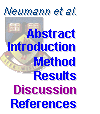| INABIS '98 Home Page |
|
Your Poster Session |
|
Related Symposia & Posters |
|
Plenary Sessions |
|
Exhibitors' Foyer |
|
Personal Itinerary |
|
New Search |

The present experiment failed to replicate Siddle et al's (1996)10 finding that the difference in secondary RT between stimulus types at a particular probe position is dependent on the nature of the counting task. It is difficult to determine if procedural differences between Siddle et al's experiment and the present experiment may have contributed to the contrasting results. The two experiments differed in several aspects and any of these differences may have contributed to the different results (e.g., the present study used visual orienting stimuli whereas Siddle et al. used auditory stimuli). However, it may be argued that the present experiment had more statistical power because it used double the observations employed by Siddle et al. The increased power may have increased the reliability of the differences at each probe position.
More false alarms occured during task-relevant shapes than during task-irrelevant shapes. False alarms represent cases when a subject incorrectly makes an RT response to a shape presentation rather than to the probe stimulus. The presence of false alarms represents a confound in the RT data as they may be wrongly taken as "real" responses. It may be possible that RT responses from false alarms are faster than responses to the RT probes. If this is the case, false alarms may produce a bias in favour of the dissociation effect. Further work is needed to determine if this bias does occur and to specify how large the bias may be.
Secondary task RT showed a downward trend across probe positions that was parallel for each stimulus type. Figure 5 shows the trend when the data are collapsed across groups. The pattern replicates that reported by Neumann et al. (1998)8 when a between groups design was used. The parallel downward trend may reflect the underlying processes which cause the dissociation effect.

Neumann et al. (1998)8 noted the similarity betwen the downward trend in secondary RT and the psychological refractory period (PRP) effect. The paradigm which yeilds the PRP effect involves presenting subjects with two stimuli (S1 and S2) separated by a stimulus onset asynchrony (SOA) and asking them to make a speeded response to both S1 (RT1) and S2 (RT2). Results show that RT1 does not differ across SOAs. However, RT2 shortens as the SOA is increased resulting in a downward trend across SOAs similar to that observed in the present experiment.
Pashler (1994)11 has suggested that the PRP effect reflects a serial processing mechanism. Specifically, he suggests that there is serial processing of a decisional and response selection stage. In a similar manner, the dissociation effect may be due to a serial processing mechanism. The slowing of secondary RT may occur because responding to the RT probe is delayed until the response selection stage in the counting task (i.e., count duration or ignore) is made. This explains why secondary RT becomes slower the earlier a probe is presented. Secondary RT may be slower during task-irrelevant stimuli than during task-relevant stimuli because of a difference in the length of a processing stage up to and/or including the response selection stage during the orienting stimuli. Recent studies suggest that this difference in length may be related to the process of discriminating between the orienting stimuli10.
The serial processing explanation of secondary RT has implications for studies which aim to measure processing resources using secondary task RT. These studies include those that assess human workload demands in environments such as aircraft cockpits and power plant control panels12. The secondary task RT method is also used in a variety of experimental investigations of psychological phenomena such as attention and memory13. Thus, the present study may add to the increasing volume of research which suggests that the assumption that secondary task RT is a measure of processing resources may not be valid in all situations.

An explanation of the dissociation
effect based on a serial processing mechanism also has implications for
resource allocation models or orienting. It suggests that orienting
(and the allocation of processing resources) may occur following this serial
process, at least when multiple stimuli are presented in quick succession.
| Correspondence to: D.Neumann@ccrn.uwa.edu.au |